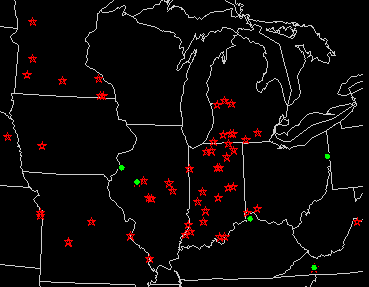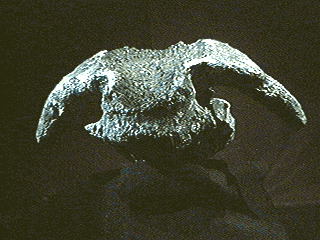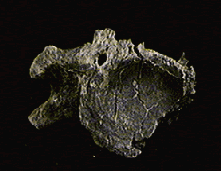
photograph by Russ Graham.

photograph by Russ Graham.
At least two species of muskoxen inhabited the midwestern U.S. during the last Ice Age: the muskox (Ovibos moschatus) and the extinct woodland muskox (Bootherium bombifrons).
 Ovibos
moschatus is the same muskoxen still found
in the artic today(map on the right). The range follows Hall
and Kelson (1959). Modern Ovibos stand about 130 cm (4 ft) tall at the
shoulder and usually weigh anywhere from 200 to 410 kg (440 to
900 lbs). Their thick coat and compact build are excellent adaptations
to living in the arctic.
Ovibos
moschatus is the same muskoxen still found
in the artic today(map on the right). The range follows Hall
and Kelson (1959). Modern Ovibos stand about 130 cm (4 ft) tall at the
shoulder and usually weigh anywhere from 200 to 410 kg (440 to
900 lbs). Their thick coat and compact build are excellent adaptations
to living in the arctic.
 However, when glaciers expanded south into the Midwest,
arctic animals like the muskox found hospitable habitat in the
area. This map shows some of the sites at which the woodland muskox
(Bootherium bombifrons) and the muskox (Ovibos
mochatus) have been found in the midwestern United States.
Red stars indicate sites from which Bootherium
bombifrons has been recovered. Ovibos mochatus has
been recovered from the site is shown with green dots.
However, when glaciers expanded south into the Midwest,
arctic animals like the muskox found hospitable habitat in the
area. This map shows some of the sites at which the woodland muskox
(Bootherium bombifrons) and the muskox (Ovibos
mochatus) have been found in the midwestern United States.
Red stars indicate sites from which Bootherium
bombifrons has been recovered. Ovibos mochatus has
been recovered from the site is shown with green dots.
The sites on this map are all relatively well-dated and well-studied. These sites contain bones that are between 40,000 and 11,500 years old.
The second species of muskoxen found in the midwestern U.S.,
the extinct woodland muskox (Bootherium bombifrons),
was apparently much more common (horn shown to the left).
 As its name implies, the woodland muskox is thought to have
lived in woodlands and plains.
As its name implies, the woodland muskox is thought to have
lived in woodlands and plains.
 Remains of this muskox, such as the vertebra in the image, are relatively
common throughout the midwestern U.S.. Bootherium bombifrons has a very
interesting history. The original specimen was found at Big Bone Lick, KY on
an expedition sent by Thomas Jefferson.
Remains of this muskox, such as the vertebra in the image, are relatively
common throughout the midwestern U.S.. Bootherium bombifrons has a very
interesting history. The original specimen was found at Big Bone Lick, KY on
an expedition sent by Thomas Jefferson.
For many years paleontologists thought at least two different types of woodland muskoxen were present in the Midwest 16,000 years ago. The two types were a form with larger, heavier horns with an oval cross-section (that was named Symbos cavifrons) and a form with smaller, more slender horns with a rounder cross-section (the original Bootherium bombifrons ). Now many paleontologists consider these two forms represent the male and female of a single species (correctly named Bootherium bombifrons). This conclusion is discussed in detail in McDonald and Ray (1989).
The living muskox was one of the relatively few large mammals in North America that did not go extinct approximately 11,500 years ago. The woodland muskox was not as lucky. The reason for the extinction of the woodland muskox and survival of the muskox is being studied by paleontologists.